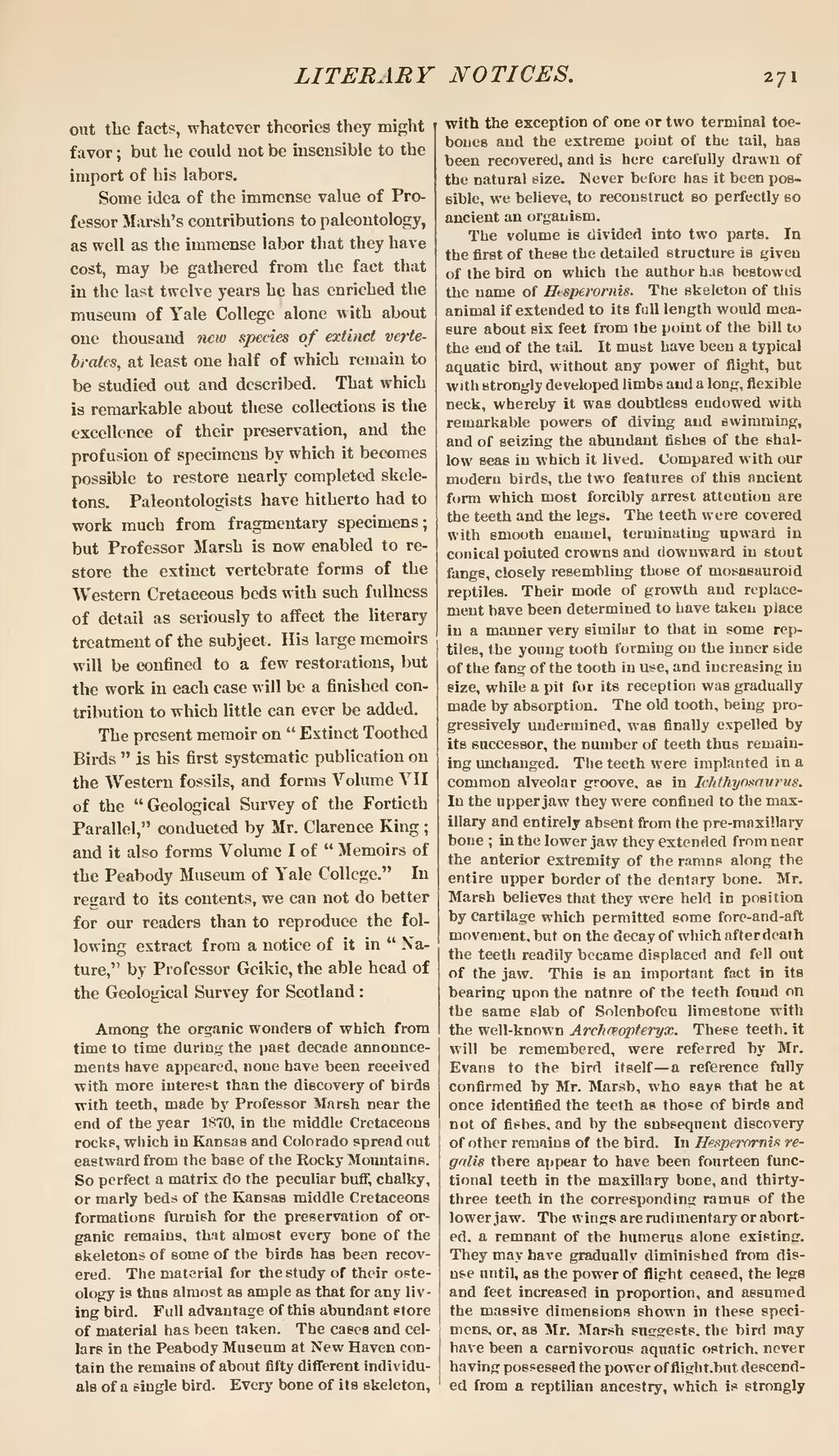out the facts, whatever theories they might favor; but he could not be insensible to the import of his labors.
Some idea of the immense value of Professor Marsh's contributions to paleontology, as well as the immense labor that they have cost, may be gathered from the fact that in the last twelve years he has enriched the museum of Yale College alone with about one thousand new species of extinct vertebrates, at least one half of which remain to be studied out and described. That which is remarkable about these collections is the excellence of their preservation, and the profusion of specimens by which it becomes possible to restore nearly completed skeletons. Paleontologists have hitherto had to work much from fragmentary specimens; but Professor Marsh is now enabled to restore the extinct vertebrate forms of the Western Cretaceous beds with such fullness of detail as seriously to affect the literary treatment of the subject. His large memoirs will be confined to a few restorations, but the work in each case will be a finished contribution to which little can ever be added.
The present memoir on "Extinct Toothed Birds" is his first systematic publication on the Western fossils, and forms Volume VII of the "Geological Survey of the Fortieth Parallel," conducted by Mr. Clarence King; and it also forms Volume I of "Memoirs of the Peabody Museum of Yale College." In regard to its contents, we can not do better for our readers than to reproduce the following extract from a notice of it in "Nature," by Professor Geikie, the able head of the Geological Survey for Scotland:
Among the organic wonders of which from time to time during the past decade announcements have appeared, none have been received with more interest than the discovery of birds with teeth, made by Professor Marsh near the end of the year 1870, in the middle Cretaceous rocks, which in Kansas and Colorado spread out eastward from the base of the Rocky Mountains. So perfect a matrix do the peculiar buff, chalky, or marly beds of the Kansas middle Cretaceons formations furnish for the preservation of organic remains, that almost every bone of the skeletons of some of the birds has been recovered. The material for the study of their osteology is thus almost as ample as that for any living bird. Full advantage of this abundant store of material has been taken. The cases and cellars in the Peabody Museum at New Haven contain the remains of about fifty different individuals of a single bird. Every bone of its skeleton, with the exception of one or two terminal toe bones and the extreme point of the tail, has been recovered, and is here carefully drawn of the natural size. Never before has it been possible, we believe, to reconstruct so perfectly so ancient an organism.
The volume is divided into two parts. In the first of these the detailed structure is given of the bird on which the author has bestowed the name of Hesperornis. The skeleton of this animal if extended to its full length would measure about six feet from the point of the bill to the end of the tail. It must have been a typical aquatic bird, without any power of flight, but with strongly developed limbs and a long, flexible neck, whereby it was doubtless endowed with remarkable powers of diving and swimming, and of seizing the abundant fishes of the shallow seas in which it lived. Compared with our modern birds, the two features of this ancient form which most forcibly arrest attention are the teeth and the legs. The teeth were covered with smooth enamel, terminating upward in conical pointed crowns and downward in stout fangs, closely resembling those of mosasauroid reptiles. Their mode of growth and replacement have been determined to have taken place in a manner very similar to that in some reptiles, the young tooth forming on the inner side of the fang of the tooth in use, and increasing in size, while a pit for its reception was gradually made by absorption. The old tooth, being progressively undermined, was finally expelled by its successor, the number of teeth thus remaining unchanged. The teeth were implanted in a common alveolar groove, as in Ichthyosaurus. In the upper jaw they were confined to the maxillary and entirely absent from the pre-maxillary bone; in the lower jaw they extended from near the anterior extremity of the ramns along the entire upper border of the dentary bone. Mr. Marsh believes that they were held in position by cartilage which permitted some fore-and-aft movement, but on the decay of which after death the teeth readily became displaced and fell out of the jaw. This is an important fact in its bearing upon the nature of the teeth found on the same slab of Solenhofeu limestone with the well-known Archæopteryx. These teeth, it will be remembered, were referred by Mr. Evans to the bird itself—a reference fully confirmed by Mr. Marsh, who says that he at once identified the teeth as those of birds and not of fishes, and by the subsequent discovery of other remains of the bird. In Hesperornis regalis there appear to have been fourteen functional teeth in the maxillary bone, and thirty-three teeth in the corresponding ramus of the lower jaw. The wings are rudimentary or aborted, a remnant of the humerus alone existing. They may have gradually diminished from disuse until, as the power of flight ceased, the legs and feet increased in proportion, and assumed the massive dimensions shown in these specimens, or, as Mr. Marsh suggests, the bird may have been a carnivorous aquatic ostrich, never having possessed the power of flight, but descended from a reptilian ancestry, which is strongly
